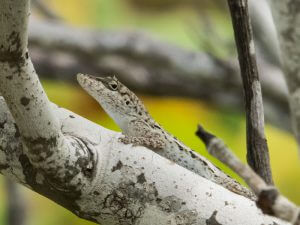Mangrove forests play a critical role in the island’s overall environmental health. These forests act as important breeding, habitat and nursery areas for a wide variety of fish, crustaceans and birds. These forests act as a natural water filter, improving overall water quality which benefits not only its inhabitants but neighboring habitats such as seagrass beds and coral reefs. Mangroves are known carbon sinks, working to sequester carbon dioxide improving air quality. Mangrove trees and roots act as a physical barrier between land and sea, protecting coastlines from storm surges, erosion and the threat of sea level rise. Furthermore, these forests offer a rare reprieve from the otherwise dry desert conditions, serving as a popular recreational location for residents and tourists alike.
A wide variety of invertebrates, fish and birds rely on this habitat as well. Over 100 species of fish have been documented in and around this area, in addition, other species such as the Spotted Eagle Rays (Aetobatus narinari), green sea turtle (Chelonia mydas), various species of Moray Eels and young sharks can also be seen along the forest edges. A variety of local and migratory birds are also known to inhabit the mangrove forests, particularly in winter months.
Bonaire
Bonaire is unique as it is the only Dutch Caribbean island to have a significant mangrove forest. This area provides important ecosystem services in the form of coastal protection, important nursery and foraging areas for many species of fish, crustaceans and birds, along with supporting other important habitats such as seagrass and coral reefs. Traditionally these forests are well adapted to rising sea-levels (McKee et al. 2007), however additional pressures due to climate change, urbanization, tourism and over exploitation are now putting this habitat at risk (Simpson et al., 2011; Polidoro et al., 2010).
Lac Bay is the largest lagoon on the island of Bonaire, and is located along the south eastern coast. The northern area of the bay is covered in mangroves, and the southern portion is open, protected from the open ocean by a barrier reef. Lac has the most significant portion of the island’s mangroves with about 2.5km2 of the total of 7.5km2. Four different species can be found within these forests: red mangrove (Rhizophora mangle), black (Avicennia germinans), white (Laguncularia racemes) and buttonwood (Conocarpus erectus).

